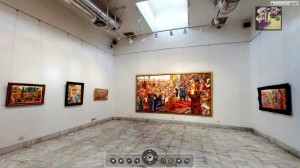
(Photo from fineart.gov.eg)
Navigating through Cairo has become somewhat of a pain in the neck. Ever since the curfew has been applied, the city has been suffering from horrendous traffic, especially since many streets remain closed. This makes one reluctant to go anywhere after work and the stress of it all makes staying home on the weekend all too tempting.
Cleverly, the Ministry of Culture’s art section decided to provide virtual tours of the most famous Egyptian museums on its website. “Now, art lovers in Egypt and anywhere in the world can visit national and artistic museums on the website, where they can have virtual tours of them,” says Dr Salah El-Meleegy, head of the art section at the ministry. “They can also enjoy the exciting panoramic views with one click.”
Visitors will be able to view the highlights of each museum, which includes works by international artists as well as historical artefacts from the region. The project includes the Islamic Ceramics Museum, which exhibits artifacts from many periods such the Fatimid, Umayyad and Mamluke periods, among others. It also includes several art museums such as the Mohamed Nagy Museum and the Mahmoud Moukhtar Museum.
While the effort is commendable, the problem is that some of the museum websites have not been updated in a while. In addition, some of the links of the acquisitions or artifacts do not work. Attempting to view the collections on the Mohamed Mahmoud Khalil Museum website, for example, only yields a server error. The panoramic tours of the museums are very interesting, but are more aesthetic than functional in nature. They do not provide information whilst taking the tour, nor do they point you to important exhibits.
The project might be the first step towards developing a comprehensive touristic database online, but it is a bit premature to launch it to the public. It would have been better to take some time to enhance the website to make sure everything is working correctly. The website could have also benefited from some user-friendly interface and more sophisticated graphics.
One museum website in particular that seemed promising was the Glass Art Museum. The website’s interface was very easy to use and the inviting. The English version had most of the museum’s collection uploaded and the links did work. While it did not have a panoramic tour, the website was functional and provided all the information needed. Clearly, there was some care and attention given in its development, having been designed in 2004 by Tarek Hawas.
The ministry of culture should take its cue from this and try to apply the methodology to all the other websites. This will ensure that people would actually be interested in visiting the virtual museums and spending time going through the exhibits. Otherwise, the ministry is just squandering time, money and considerable effort on a good idea, but with bad execution.




